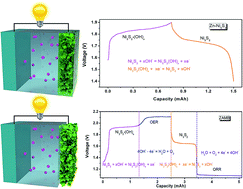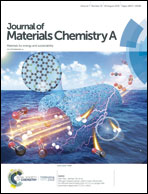Ni3S2/Ni nanosheet arrays for high-performance flexible zinc hybrid batteries with evident two-stage charge and discharge processes†
Abstract
Safety and brilliant electrochemical performance are the most important elements for advanced battery systems. Aqueous Zn batteries are considered a promising technology to meet the safety requirements, but are limited by their inferior electrochemical properties. Combining with zinc–air batteries is an effective way to improve the energy density of Zn batteries by introducing the oxygen evolution reaction and the oxygen reduction reaction into the whole electrochemical process. Hence, Ni3S2 nanosheets were utilized as a novel cathode for both Zn batteries and hybrid Zn–air–metal batteries (ZAMBs), of which the energy storage mechanisms were clearly demonstrated. The hybrid ZAMBs exhibited an evident two-stage charge and discharge process and displayed highly stable discharge platforms of 1.7 V and 1.1 V, and could work for more than 300 hours, uninterruptedly. More importantly, sodium polyacrylate served as the separator for the flexible hybrid Zn battery prototype, which shows superior electrochemical properties in an alkaline environment to other hydrogel membranes. This work could introduce a novel method to greatly improve the energy density of Zn batteries and further promote the development of hybrid Zn battery systems.



 Please wait while we load your content...
Please wait while we load your content...